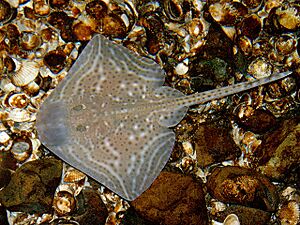Smalleyed ray facts for kids
Quick facts for kids Smalleyed ray |
|
|---|---|
 |
|
| Conservation status | |
| Scientific classification |
The smalleyed ray or smalleyed skate (Raja microocellata) is a type of ray that lives in the eastern Atlantic Ocean. It belongs to the Rajidae family, which includes many typical rays and skates. You can find these rays in shallow, coastal waters, especially where the bottom is sandy.
Contents
What Does the Smalleyed Ray Look Like?
The smalleyed ray is a smaller kind of skate. It can grow up to about 87 centimeters (34 inches) long. It can also weigh around 4.5 kilograms (10 pounds). Like other rays, its body is flat from top to bottom. It has very small eyes and spiracles (breathing holes) on top of its head.
Its snout, or nose, is pointed. Its tail starts from its wide, diamond-shaped body. The ray's color can be grayish-olive or light brown. It often has lighter spots on its back. You might also see pale lines that run along the edges of its "wings." Its belly is white. It has small spines along its tail and down the middle of its body. These spines are very close together.
Where Do Smalleyed Rays Live?
Smalleyed rays live in the eastern part of the Atlantic Ocean. They are found from the southwestern waters of Great Britain and Ireland. Their range extends south to the Rio de Oro in the Western Sahara.
However, you won't find them in the North Sea or the Mediterranean Sea. In Britain and Ireland, they are most common in the Bristol Channel and off the coast of Ireland.
Home and Habits of the Smalleyed Ray
Smalleyed rays prefer shallow waters. They usually live in water less than 100 meters (330 feet) deep. They like to hunt over sandy, muddy, or lightly pebbled seabeds. These rays are even known to swim into river mouths, called estuaries.
What Do Smalleyed Rays Eat?
The main food for smalleyed rays is fish. They also enjoy eating squid. They are "ambush predators." This means they hide by burying themselves in the sand or mud. When prey swims close enough, they quickly launch themselves out to catch it. They also eat other small sea creatures like worms and crabs. Sometimes, they will even eat dead fish they find.
Smalleyed Ray Life Cycle
Smalleyed rays lay eggs. This is called being oviparous. When it's time to mate, the male and female rays come together in a special embrace. The female then lays between 54 and 61 eggs. These eggs are inside rectangular capsules. Each capsule is about 6.6 to 10 centimeters (2.6 to 3.9 inches) long. They are also about 4.1 to 6.3 centimeters (1.6 to 2.5 inches) wide. Each corner of the capsule has a stiff "horn."
The female lays these egg capsules in sandy or muddy areas. Once the young rays hatch, they tend to follow larger objects. This can even include their own mother.
Smalleyed Rays and People
Smalleyed rays are important for local fishing. They are caught using special nets called otter trawls or set-nets. Sometimes, they are also caught by accident. This is called "bycatch." It happens when fishing boats are trying to catch other types of fish. Smaller smalleyed rays caught this way are usually thrown back into the sea.
Interestingly, catching too many larger skates might have helped the smalleyed ray population. This is because larger skates are known to eat smalleyed rays. With fewer large skates around, more smalleyed rays might survive.
Protecting the Smalleyed Ray
The IUCN (International Union for Conservation of Nature) lists the smalleyed ray as "Near Threatened." This means they are close to being considered "Vulnerable." They have this status for a few reasons. They live in a limited area, and their populations are spread out. This makes them sensitive to too much fishing. They are also at risk from habitat destruction and other human activities.
Scientists believe their numbers have dropped by almost 30%. This is mainly because of high levels of fishing. The IUCN has said that the smalleyed ray is very close to meeting the requirements to be listed as a Vulnerable species.
How the Smalleyed Ray Got Its Name
The scientific name for this ray is Raja microocellata. It was first officially described by an English naturalist named George Montagu. He published his description in 1818, after he had passed away. The place where he found the first described ray was the south coast of Devonshire.
The name microocellata means "small-eyed." This name perfectly describes the small eyes that this ray has.


